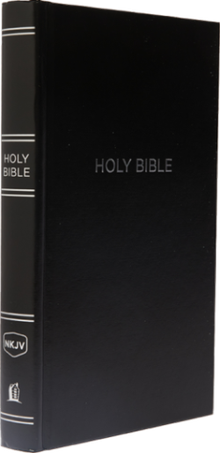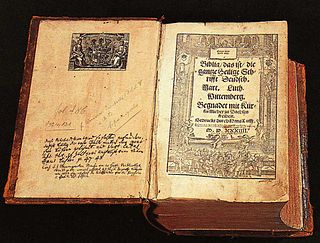
Today's New International Version (TNIV) is an English translation of the Bible which was developed by the Committee on Bible Translation (CBT). The CBT also developed the New International Version (NIV) in the 1970s. The TNIV is based on the NIV. It is explicitly Protestant like its predecessor; the deuterocanonical books are not part of this translation. The TNIV New Testament was published in March 2002. The complete Bible was published in February 2005. The rights to the text are owned by Biblica. Zondervan published the TNIV in North America. Hodder & Stoughton published the TNIV in the UK and European Union.

The New Living Translation (NLT) is a translation of the Bible in contemporary English. Published in 1996 by Tyndale House Foundation, the NLT was created "by 90 leading Bible scholars." The NLT relies on recently published critical editions of the original Hebrew, Aramaic, and Greek texts.

The English Standard Version (ESV) is a translation of the Bible in contemporary English. Published in 2001 by Crossway, the ESV was "created by a team of more than 100 leading evangelical scholars and pastors." The ESV relies on recently published critical editions of the original Hebrew, Aramaic, and Greek texts.

The New American Standard Bible is a translation of the Bible in contemporary English. Published by the Lockman Foundation, the complete NASB was released in 1971. New revisions were published in 1995 and 2020. The NASB relies on recently published critical editions of the original Hebrew, Aramaic, and Greek texts. It is known for preferring a literal translation style that generally preserves the structure of the original language when possible, rather than an idiomatic style that attempts to match natural English usage.
The New International Reader's Version (NIrV) is a translation of the Bible in contemporary English. Translated by the International Bible Society following a similar philosophy as the New International Version (NIV), but written in a simpler form of English, this version seeks to make the Bible more accessible for children and people who have difficulty reading English, such as non-native English speakers. The authors describe it as a special edition of the NIV written at a third grade reading level.

The New King James Version (NKJV) is a translation of the Bible in contemporary English. Published by Thomas Nelson, the complete NKJV was released in 1982. With regard to its textual basis, the NKJV relies on a modern critical edition for the Old Testament, while opting to use the Textus Receptus for the New Testament.

Modern English Bible translations consists of English Bible translations developed and published throughout the late modern period to the present.

The Recovery Version is a modern English translation of the Bible from the original languages, published by Living Stream Ministry, ministry of Witness Lee and Watchman Nee. It is the commonly used translation of Local Churches (affiliation).
Gordon Donald Fee was an American-Canadian Christian theologian who was an ordained minister of the Assemblies of God (USA). He was professor of New Testament Studies at Regent College in Vancouver, British Columbia, Canada.

Wayne A. Grudem is a New Testament scholar turned theologian, seminary professor, and author. Professor of Theology and Biblical Studies at Phoenix Seminary, Phoenix, Arizona.
Zondervan is an international Christian media and publishing company located in Grand Rapids, Michigan, United States. Zondervan is a founding member of the Evangelical Christian Publishers Association (ECPA). It is a part of HarperCollins Christian Publishing, Inc. and has multiple imprints including Zondervan Academic, Zonderkidz, Blink, and Editorial Vida. Zondervan is the commercial rights holder for the New International Version (NIV) Bible in North America. According to the Zondervan website, it is the largest Christian publisher.
The NIV Study Bible is a study Bible originally published by Zondervan in 1985 that uses the New International Version (NIV). Revisions include one in 1995, a full revision in 2002, an update in October 2008 for the 30th anniversary of the NIV, another update in 2011, and a fully revised update in 2020 named "Fully Revised Edition". Its publisher and distributors claim over nine million sold, and claim that it is the world's bestselling study bible.
The New International Version Inclusive Language Edition (NIVi) of the Christian Bible was an inclusive language version of the New International Version (NIV). It was published by Hodder and Stoughton in London in 1995; New Testament and Psalms, with the full bible following in 1996. It was only released in the United Kingdom and British Commonwealth Countries.
Olive Tree Bible Software creates Biblical software and mobile apps, and is an electronic publisher of Bible versions, study tools, Bible study tools, and Christian eBooks for mobile, tablet, and desktop devices. The firm is headquartered in Spokane, Washington and is a member of the Evangelical Christian Publishers Association (ECPA). Olive Tree currently supports Android, iPad, iPhone, Macintosh, Windows, and personal computer devices.
Vern Sheridan Poythress is an American philosopher, theologian, New Testament scholar and mathematician, who is currently the New Testament chair of the ESV Oversight Committee. He is also the Distinguished Professor of New Testament, Biblical Interpretation, and Systematic Theology at Westminster Theological Seminary and editor of Westminster Theological Journal.
The Common English Bible (CEB) is an English translation of the Bible whose language is intended to be at a comfortable reading level for the majority of English readers. The translation, sponsored by an alliance of American mainline Protestant denomination publishers, was begun in late 2008 and was finished in 2011. It uses gender-inclusive language and some editions sold include the books of the Apocrypha which are used by the Catholic Church, Orthodox Church, and in some Anglican congregations.
Mark Lehman Strauss is an American biblical scholar and professor of the New Testament at Bethel Seminary San Diego, which is part of Bethel University, Minnesota. His areas of expertise include New Testament Gospels and Bible translation.

A Protestant Bible is a Christian Bible whose translation or revision was produced by Protestant Christians. Typically translated into a vernacular language, such Bibles comprise 39 books of the Old Testament and 27 books of the New Testament, for a total of 66 books. Some Protestants use Bibles which also include 14 additional books in a section known as the Apocrypha bringing the total to 80 books. This is in contrast with the 73 books of the Catholic Bible, which includes seven deuterocanonical books as a part of the Old Testament. The division between protocanonical and deuterocanonical books is not accepted by all Protestants who simply view books as being canonical or not and therefore classify books found in the Deuterocanon, along with other books, as part of the Apocrypha. Sometimes the term "Protestant Bible" is simply used as a shorthand for a bible which contains only the 66 books of the Old and New Testaments.
Barry J. Beitzel is an Old Testament scholar, geographer, cartographer, and translator of the Bible. He currently resides in Mundelein, Illinois.

The Christian Standard Bible (CSB) is a translation of the Bible in contemporary English. Published by Holman Bible Publishers in 2017 as the successor to the Holman Christian Standard Bible (HCSB), the CSB "incorporates advances in biblical scholarship and input from Bible scholars, pastors, and readers to sharpen both accuracy and readability." The CSB relies on recently published critical editions of the original Hebrew, Aramaic, and Greek texts.










